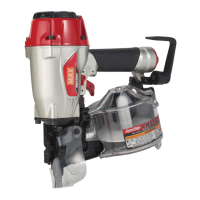
Do you have a question about the Max SuperSider CN565S3 and is the answer not in the manual?
| Brand | Max |
|---|---|
| Model | SuperSider CN565S3 |
| Category | Power Tool |
| Language | English |
Ensures eye protection is worn, conforming to ANSI Z87.1 standards for frontal and side protection.
Highlights the need for hearing protection in high noise level environments to prevent hearing damage.
Avoid placing hands or body parts in the fastener discharge area to prevent accidental injury.
Prohibits the use of fastener driving tools on scaffoldings and ladders with contact actuation.
Stipulates using only compressed air and warns against other gases due to explosion risk.
Prohibits operation near flammable substances or in explosive atmospheres to prevent ignition.
Warns against wrong fittings and mandates disconnecting air supply and emptying the magazine when not in use.
Ensures all screws and bolts are tight and properly installed before operation to prevent accidents.
Avoid touching the trigger unless driving a fastener and never point the discharge outlet at others.
Use specified fasteners, place outlet properly, avoid edges, and do not drive fasteners on top of others.
Check trip mechanism, use tool safely in elevated places, and never operate with inoperable controls.
Avoid actuating tool into free space, assume fasteners are loaded, respect the tool, and no horseplay.
Wear protective gear, do not use as a hammer, carry by grip, use only for design purpose, and keep away from children.
Follow national rules for disposal and do not modify the tool without manufacturer approval.
Details tool dimensions, weight, loading capacity, air consumption, and identifies key components.
Lists compatible collation types, shank types, nail lengths, shank diameters, and head diameters.
Covers air fittings, hoses, supply source requirements, and the use of a 3-piece airset.
Provides A-weighted sound power and emission levels, and vibration characteristic values.
Includes wearing safety gear, checking screws, confirming trigger/arm function, and testing for air leaks.
Details safe operation, including wearing safety glasses and keeping hands away from the discharge outlet.
Step-by-step guide for opening the magazine, adjusting the nail support, and loading nails.
Instructions for testing the tool's firing mechanism and adjusting air pressure for optimal performance.
Explains how to use the adjustment dial to control fastener driving depth, with safety warnings.
Describes the trigger lock function to prevent accidental firing.
Details how to change the direction of the exhaust air, with a safety warning.
Instructions for changing the hook direction and removing used plastic collation sheets.
Step-by-step guide for reassembling the contact nose, including safety precautions.
Identifies different contact trip mechanisms and their operating procedures.
Covers not firing empty, using a 3-piece airset, using recommended oil, and daily inspection.
Guidelines for storing the tool properly to prevent rust and damage, especially in cold weather.
States that troubleshooting and repairs should only be performed by authorized distributors or specialists.
